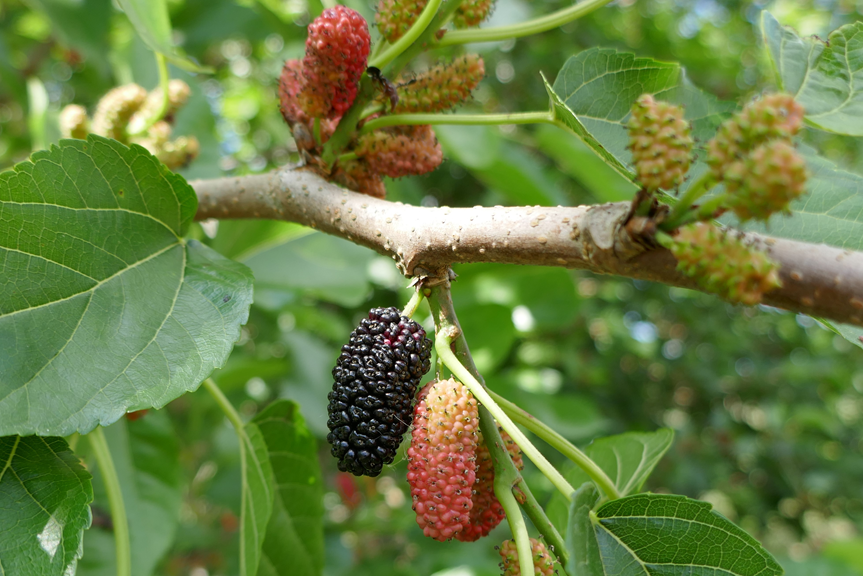Mark Bailey: Mulberry: The easy fruit tree

Some fruit trees are difficult to grow and take many years before they begin to produce fruit. This is not the case with the mulberry tree. Mulberries in Florida are one of the fastest-growing fruit-bearing trees that require the least amount of effort to grow an abundance of fruit. Mulberries belong to the family Moraceae, which also contains other well-known trees like the fig, breadfruit, banyan, jackfruit, Osage orange and the invasive paper mulberry.
Mulberries include several fruit-bearing species, and they are grown throughout the world. They are well-adapted to a wide range of environmental and soil conditions, allowing them to be successfully grown throughout the southeast. Mulberries will grow best in well-drained soil and full sun. Among the most common trees planted are the native red mulberry (Morus rubra), black mulberry (Morus nigra), Pakistan mulberry (Morus macroura) and white mulberry (Morus alba). The non-native white mulberry is used for silkworm production in Asia, though it has the potential to be invasive in Florida.
A great characteristic of mulberries is their extremely rapid growth and fruit production. Most mulberries will grow in excess of 10 feet per year, and produce fruit within the first year — or much sooner. Fruit is typically produced along with the first flush of new growth that emerges in late winter. Fruit matures quickly, and will turn red and finally a dark red or purple once the fruit is fully mature. Fruit commonly matures in early spring, though some varieties produce fruit intermittently throughout the year, hence the name “ever-bearing.” Once the fruit is mature, they tend to drop from the trees, which can make harvest difficult or cause stains on driveways or sidewalks. Wildlife, particularly birds, will be attracted to the fruit, so it is important to harvest the fruit as soon as they are ripe. The fruit looks superficially similar to blackberries, and tends to have a sweeter flavor than blackberries. Also, they are not seedy like blackberries, and they make for a pleasant eating experience. Because they are so thin-skinned, mulberries have a very short shelf life and are best eaten within a day or two of harvest. The fruit can be dried, and is especially useful for jams and jellies.
Commercial production of fruit mainly occurs in East Asia, though it does have some potential for local production in Florida. For those who are interested in growing their own mulberries, they are an excellent addition to any landscape. All mulberries will drop some or all of their leaves in a cold winter. Red and black mulberries can grow into full-sized trees, while “dwarf” varieties are a good choice for those with limited space or who do not want to manage excessive growth.
If the mulberry is pruned, it is one of the easiest plants to propagate from cuttings. Cuttings will need to be at least the length and diameter of a pencil. Cuttings can then be dipped in rooting hormone powder and planted in potting soil, with the top pointed upward, about 4 inches deep. Water the cuttings with some regularity to ensure the cuttings do not dry out. Successful propagation will be higher if this is done during the cool season. After several months, the cuttings should produce new leaves — and even potentially new fruit. When planting the newly propagated plant, be especially careful not to damage any of the root when transferring from a pot to soil.
Mulberries tend to have few significant pests, which allows them to be grown with no need for pesticide application. Most mulberries, when grown in good soil and full sun, also should not require any fertilizer inputs to grow a healthy and productive tree. If quick fruit production and low maintenance are desired, look no further than the mulberry.
For more information, call the Marion County Extension office at 671-8400 or email ironhill@ufl.edu.
— Mark Bailey is the Sustainable Agriculture and Food Systems Extension Agent for UF/IFAS Extension Marion County. For more information, contact the Marion County office at 671-8400. The Extension Service is located at 2232 NE Jacksonville Road, Ocala, FL 34470.
This article originally appeared on The Gainesville Sun: Mark Bailey: Mulberry: The easy fruit tree

